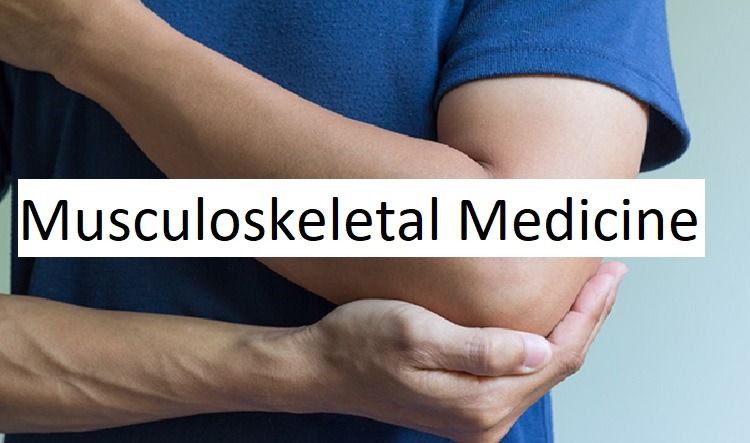Table of Contents
Musculoskeletal disorders can be a major hindrance in everyday life, causing pain and discomfort. They affect people of all ages and are caused by various factors such as lifestyle, genetics, and injuries. Understanding the root cause of musculoskeletal problems is essential for effective treatment. This comprehensive guide will cover everything you need to know about musculoskeletal medicine. We’ll explain what musculoskeletal medicine is and the role of specialists in treating these disorders. We’ll also discuss common disorders such as arthritis, back pain, and tendinopathy along with prevention techniques. Additionally, we’ll delve into the services offered by musculoskeletal clinics such as pain management techniques, physical therapy, injections, and X-ray facilities. Lastly, we’ll talk about understanding the risks involved with these disorders and answer frequently asked questions regarding nerve impingement, ultrasound in musculoskeletal medicine, and nutritional therapy for musculoskeletal health.
What is Musculoskeletal Medicine?
Musculoskeletal medicine is a specialized field that deals with the diagnosis and treatment of conditions related to bones, joints, muscles, and connective tissues. This branch of medicine focuses on helping patients manage their musculoskeletal conditions through various techniques like medications, physical therapy, and surgery.
Some of the most common musculoskeletal conditions include arthritis, osteoporosis, back pain, and sports injuries. These conditions can significantly impact an individual’s quality of life by limiting mobility and causing discomfort. Musculoskeletal specialists play a critical role in ensuring the health and mobility of individuals across all age groups. By providing comprehensive care for these types of conditions, they help patients achieve better outcomes and improve overall quality of life.
The Role of Musculoskeletal Specialists
Musculoskeletal medicine is a specialty that focuses on the diagnosis and treatment of injuries and disorders affecting the musculoskeletal system. This includes bones, joints, muscles, ligaments, and tendons. Musculoskeletal specialists may include orthopedic surgeons, physical therapists, rheumatologists, and sports medicine physicians. Together, they provide comprehensive care for patients with musculoskeletal conditions.
The goal of musculoskeletal medicine is to improve function and quality of life by reducing pain and restoring mobility. Treatment options may vary depending on the specific condition but can include medication, physical therapy, injection therapies, and surgery. By working together, musculoskeletal specialists can provide effective care that helps patients live more active and pain-free lives.
Benefits of Choosing Musculoskeletal Medicine
Musculoskeletal medicine is a medical specialty that focuses on the diagnosis and treatment of disorders of the musculoskeletal system, which includes bones, joints, muscles, and connective tissues. It employs a multidisciplinary approach to treatment that often involves physical therapy, medication management, and minimally invasive procedures.
Choosing musculoskeletal medicine can provide several benefits for patients. For example, it can improve pain management, increase mobility, and reduce reliance on surgery. Musculoskeletal medicine can be particularly effective for chronic conditions such as arthritis or back pain.
Working with a musculoskeletal specialist can help you develop a personalized treatment plan based on your specific needs and goals. By taking a comprehensive approach to diagnosis and treatment, musculoskeletal medicine can help you achieve greater comfort and functionality in your daily life.
Common Musculoskeletal Disorders
Musculoskeletal disorders refer to conditions that affect the bones, muscles, and joints. Arthritis, a condition that causes inflammation and pain in the joints, is one of the most common musculoskeletal disorders. Osteoporosis is another common disease that weakens bones and makes them more susceptible to fractures.
Tendinitis is a condition characterized by inflammation of a tendon due to repetitive motion. Scoliosis is an abnormal curvature of the spine that can lead to discomfort and pain. Carpal Tunnel Syndrome occurs when there is compression of a nerve in the wrist, causing numbness and tingling in the hand and arm.
Rotator cuff injury refers to damage caused to the muscles and tendons around the shoulder joint. Herniated disc or slipped disc is a condition where the cushion between spinal discs slips out of place, causing pain and discomfort. Understanding these common musculoskeletal disorders can help you take preventive measures and seek timely treatment if needed.
Arthritis – Causes and Treatment Options
Arthritis is a common musculoskeletal disorder that affects millions of people worldwide. It occurs when the joints become inflamed, leading to pain, stiffness, and swelling. There are several different types of arthritis, including osteoarthritis and rheumatoid arthritis.
The causes of arthritis can vary depending on the type, but risk factors can include aging, genetics, injury, and infection. Treatment options for arthritis typically involve a combination of medication, physical therapy, and lifestyle changes such as weight loss and exercise.
Early diagnosis and treatment are important in managing symptoms and preventing further damage to the joints. With proper care and management, individuals with arthritis can lead active and fulfilling lives.
Back Pain – Types and Prevention Techniques
Back pain is a common musculoskeletal disorder that affects many people. It can be caused by a variety of factors, including poor posture, improper lifting techniques, and degenerative conditions like arthritis. There are two types of back pain: acute pain, which lasts for a short period of time, and chronic pain, which persists for more than 12 weeks.
Prevention techniques for back pain include maintaining good posture, exercising regularly to strengthen the muscles that support the back, and using proper lifting techniques. Treatment options for back pain range from over-the-counter pain relievers to physical therapy and surgery in severe cases. By taking preventative measures and seeking appropriate treatment when needed, individuals can manage their back pain effectively and improve their quality of life.
Tendinopathy – Symptoms and Diagnosis
Tendinopathy is a common musculoskeletal disorder that affects the tendons of the body. It occurs when there is damage or inflammation to the tendon, which can result in pain, stiffness, and weakness in the affected area. Diagnosis of tendinopathy typically involves a physical exam and imaging tests such as X-rays or MRI scans.
Treatment options for tendinopathy may include rest, physical therapy, medication, or in severe cases, surgery. Resting the affected area and avoiding activities that aggravate the condition can help reduce symptoms. Physical therapy can also be helpful in strengthening the muscles around the affected tendon.
Preventive measures such as regular exercise, proper form during physical activities and adequate rest can help reduce the risk of developing tendinopathy. By taking good care of your muscles and joints, you can maintain optimal musculoskeletal health and avoid injuries that may lead to conditions like tendinopathy.
Services Offered by Musculoskeletal Clinics
Musculoskeletal clinics offer a variety of services to diagnose and treat musculoskeletal conditions ranging from arthritis, sports injuries to back pain. The clinics provide non-surgical treatments such as physical therapy, medications, and injections for less severe cases. However, orthopedic surgery is an option for more severe musculoskeletal conditions.
Rehabilitation services are also provided after surgery or injury to aid in recovery. In addition to treatment options, these clinics also educate patients on preventative measures to reduce the risk of future injuries or conditions. Overall, musculoskeletal clinics offer comprehensive care for patients with musculoskeletal issues, ensuring they receive the best possible treatment and guidance.
Pain Management Techniques
Musculoskeletal clinics offer a wide range of services designed to diagnose and treat conditions that affect the muscles, bones, and joints. One of the most common services offered by these clinics is pain management. Pain management techniques may include physical therapy, chiropractic care, acupuncture, and medication management. Diagnostic tests such as X-rays, MRIs, and CT scans may also be used to identify the root cause of pain.
By combining different treatment modalities tailored to each patient’s unique needs, musculoskeletal clinics can help patients manage pain more effectively and improve their quality of life. Whether it’s through hands-on therapy or medication management, these clinics strive to provide comprehensive care that addresses not just symptoms but underlying causes as well.
Physical Therapy and Rehabilitation
Musculoskeletal clinics offer a variety of services to help patients manage their pain and improve their physical function. One common service offered by these clinics is physical therapy and rehabilitation. Physical therapists work with patients to develop personalized treatment plans that may include exercises, manual therapy, and modalities such as heat or ice.
Rehabilitation programs may also include education on injury prevention and wellness strategies. The goal of physical therapy and rehabilitation is to help patients regain mobility, reduce pain, and improve their overall quality of life. These services are particularly beneficial for patients recovering from injuries or surgeries, as they can help speed up the recovery process and prevent future injuries. Overall, physical therapy and rehabilitation are important components of musculoskeletal medicine that can have a significant impact on patient outcomes.
Injections – Types and Benefits
Musculoskeletal clinics offer a range of services to address pain and inflammation, including injections. Common types of injections include corticosteroids, hyaluronic acid, and platelet-rich plasma (PRP) injections.
Corticosteroids are used to reduce inflammation and provide short-term pain relief. Hyaluronic acid injections can help lubricate joints and improve mobility for those with osteoarthritis. PRP injections use a patient’s own blood to promote healing and reduce pain.
Injections can be an effective treatment option for musculoskeletal conditions when used in conjunction with other therapies. It is important to consult with a healthcare provider to determine the best treatment plan for your individual needs.
X-Ray and Ultrasound Facilities – Importance and Availability
Musculoskeletal clinics offer a range of services to diagnose and treat conditions related to the bones, muscles, and joints. One important category of services offered by such clinics is diagnostic imaging, which includes X-ray and ultrasound facilities. These tools are used to identify issues in bones and soft tissues that cannot be seen with the naked eye.
X-rays are commonly used to identify broken bones, tumors, or joint damage. Ultrasounds are another important tool that uses sound waves to produce images of internal structures. Unlike X-rays, ultrasounds do not use ionizing radiation, making them a safer option for pregnant women or young children.
Most musculoskeletal clinics have these facilities available on-site or nearby so that patients can receive prompt diagnosis and treatment. Some advanced imaging techniques like MRI or CT scans may also be available at some clinics. Overall, access to these diagnostic tools is crucial in ensuring accurate diagnoses and effective treatments for musculoskeletal conditions.
Understanding the Risks Involved
Musculoskeletal injuries can happen to anyone and from various activities, such as sports or repetitive motions at work. Ignoring musculoskeletal pain can lead to chronic issues and even disability in severe cases. That’s why it’s crucial to seek medical attention early on to prevent further damage and increase the chances of a full recovery. Treatment options for musculoskeletal injuries range from physical therapy to surgery depending on the type and severity of the injury. With proper treatment, most people can return to their pre-injury level of activity. However, as with any medical treatment, there are risks involved that need to be understood before proceeding with any procedure or intervention. It is important to discuss these risks with your healthcare provider before making any decisions regarding your musculoskeletal health.
Risk Factors Associated with Musculoskeletal Problems
Musculoskeletal problems can be caused by a variety of factors, including age, genetics, lifestyle choices, and previous injuries. Certain occupations and activities may also increase the risk of developing musculoskeletal problems. Risk factors associated with musculoskeletal issues include repetitive motions, heavy lifting or manual labor, and prolonged periods of sitting or standing.
Preventative measures such as proper posture, regular exercise, and ergonomic workspaces can help reduce the risk of musculoskeletal problems. Early diagnosis and treatment are important to prevent further damage and improve outcomes for those with existing conditions or potential risks. It’s important to work with a healthcare professional who specializes in musculoskeletal medicine to properly manage any existing conditions or potential risks. Understanding the risks involved is an important step towards maintaining healthy musculoskeletal function throughout life.
Prevention Techniques for Musculoskeletal Disorders
Musculoskeletal disorders can be caused by a variety of factors, including repetitive motions, poor posture, and overuse injuries. To help prevent these disorders, there are several prevention techniques that individuals can adopt. One effective technique is to make ergonomic adjustments such as using an adjustable chair or standing desk to reduce strain on the body.
Regular stretching can also help reduce the risk of developing musculoskeletal disorders. Taking breaks during repetitive activities and alternating between different tasks can help avoid overuse injuries. Proper lifting techniques can also help prevent back injuries and other musculoskeletal problems.
Understanding the risks involved with certain occupations or activities is crucial for taking proactive steps to protect one’s musculoskeletal health. By adopting preventive measures and understanding the potential dangers, individuals can significantly reduce their risk of developing musculoskeletal disorders.
Frequently Asked Questions About Musculoskeletal Medicine
Musculoskeletal medicine is a branch of medicine that deals with the diagnosis and treatment of conditions related to bones, muscles, ligaments, and tendons. It treats conditions such as arthritis, back pain, sports injuries, and osteoporosis. Unlike other forms of medical treatment that focus on treating symptoms or specific body systems, musculoskeletal medicine focuses on improving the overall health of the musculoskeletal system.
To diagnose musculoskeletal conditions, doctors use diagnostic tools such as X-rays, MRI scans, CT scans, and ultrasound. Treatment options include physical therapy, medication, injections, surgery, and alternative therapies like acupuncture.
Patients can prevent or manage musculoskeletal conditions by maintaining a healthy weight, exercising regularly, eating a balanced diet rich in calcium and vitamin D to strengthen bones, avoiding smoking and excessive alcohol consumption that can weaken bones and muscles. Patients should also consult their doctor if they experience any persistent pain or discomfort in their joints or muscles to prevent further damage.
Nerve Impingement – Causes and Treatment Options
Nerve impingement occurs when a nerve is compressed or pinched by surrounding tissue, such as bones, muscles, or tendons. This can result in a variety of symptoms, including pain, numbness, tingling, or weakness in the affected area. Common causes of nerve impingement include injuries, repetitive motions, and conditions like arthritis or spinal stenosis.
Treatment options for nerve impingement may include physical therapy to improve mobility and strength in the affected area, medication to manage pain and inflammation, injections to reduce swelling and pressure on the nerve, or surgery in more severe cases. It’s important to seek early diagnosis and treatment for nerve impingement in order to prevent further damage and improve overall quality of life. Your doctor or musculoskeletal specialist can work with you to determine the best course of treatment based on your individual needs and condition.
Role of Ultrasound in Musculoskeletal Medicine
Ultrasound is a non-invasive imaging technique that uses sound waves to create images of the musculoskeletal system. In musculoskeletal medicine, it plays an important role in both diagnosis and treatment. Ultrasound can be used to diagnose and guide treatment for a wide range of conditions, including fractures, sprains, and tendon injuries.
Additionally, ultrasound technology can also be used to monitor the progress of healing and guide injections or other treatments. It is often preferred over other imaging techniques because it is safe, cost-effective, and does not expose patients to radiation. Furthermore, with recent advancements in ultrasound technology, it has become an increasingly valuable tool in musculoskeletal medicine research and treatment planning. Ultimately, the use of ultrasound in musculoskeletal medicine has significantly improved patient care and outcomes.
Benefits of Nutritional Therapy in Musculoskeletal Health
Nutritional therapy can have significant benefits for musculoskeletal health by providing the body with the necessary nutrients to heal and repair. A balanced diet rich in vitamins and minerals can help reduce inflammation, improve bone density, and increase muscle strength. In addition, supplements such as omega-3 fatty acids, vitamin D, and glucosamine can support joint health.
Nutritional therapy can be used in conjunction with other treatments like physical therapy or medication for optimal results. However, it’s important to consult with a healthcare professional before starting any nutritional therapy program. Overall, incorporating nutritional therapy into your musculoskeletal health routine can help improve overall wellness and quality of life.
Musculoskeletal Medicine is a comprehensive approach to treating musculoskeletal disorders that includes various treatment options such as pain management, physical therapy, injections, and diagnostic facilities like X-rays and ultrasounds. It is important to understand common musculoskeletal disorders like arthritis, back pain, and tendinopathy to prevent them and seek timely treatment. Choosing Musculoskeletal Medicine can offer many benefits over traditional medicine like faster recovery times, fewer side effects, and more personalized treatment plans. To learn more about this field of medicine and the services offered by Musculoskeletal Clinics near you, check out our comprehensive guide.



